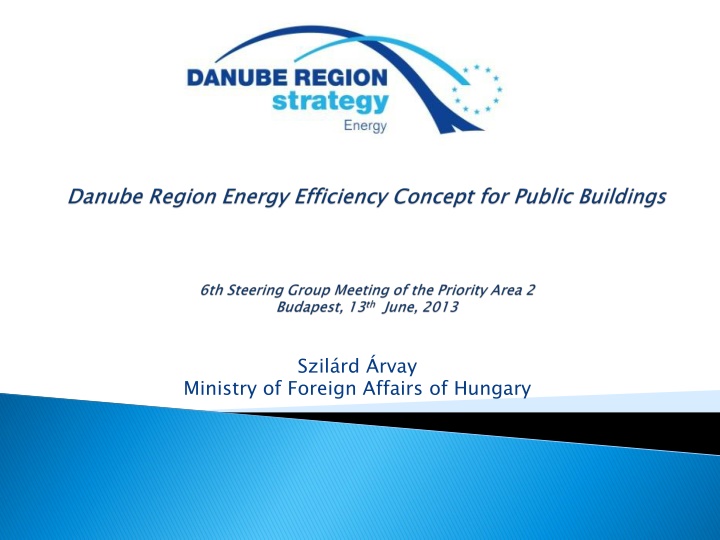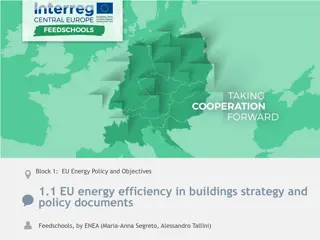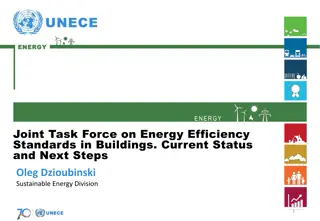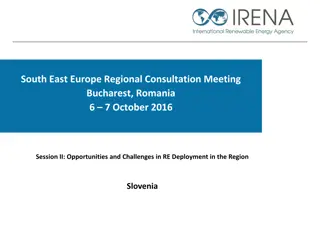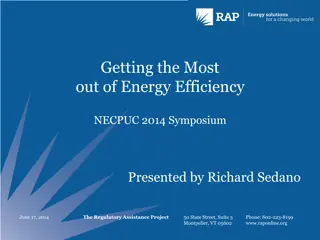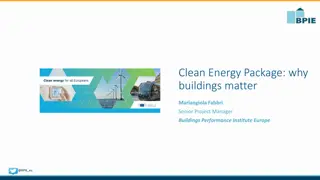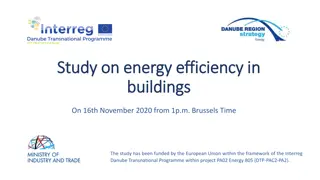Energy Efficiency in Public Buildings: A Key Driver for Achieving EU 2020 Targets
Efficient energy use in public buildings is crucial for the EU to meet its 2020 energy efficiency goals. With buildings representing a significant portion of energy consumption, actions such as renovating heating systems and providing consultative support are essential. Public buildings offer an ideal opportunity for energy efficiency investments, potentially decreasing energy intensity and promoting sustainability. Addressing these areas can not only contribute to achieving targets but also drive market transformation towards a more efficient future.
Download Presentation

Please find below an Image/Link to download the presentation.
The content on the website is provided AS IS for your information and personal use only. It may not be sold, licensed, or shared on other websites without obtaining consent from the author.If you encounter any issues during the download, it is possible that the publisher has removed the file from their server.
You are allowed to download the files provided on this website for personal or commercial use, subject to the condition that they are used lawfully. All files are the property of their respective owners.
The content on the website is provided AS IS for your information and personal use only. It may not be sold, licensed, or shared on other websites without obtaining consent from the author.
E N D
Presentation Transcript
Szilrd rvay Ministry of Foreign Affairs of Hungary
PA PA 2 2 supports supports achieving achieving EU EU- -targets targets Europe 2020 Strategy - saving 20% consumption by 2020 compared to projections made in 2007. C Continent is not on track estimate of COM: primary energy consumption in 2020 will be reduced by only about 17% EU Energy Efficiency Directive - COM shall assess progress achieved by 30 June 2014 renovation of buildings, 1st version to be published by 30 April 2014 Priority Area 2 to provide a useful input to such analyses and to promote best practice. saving 20% (368 Mtoe) (368 Mtoe) of the Union s primary energy ontinent is not on track to reach its 2020 energy efficiency goals - Recent 17%!!! by 30 June 2014 AND AND Member States shall establish a long-term strategy for the by 30 April 2014. 1528Mtoe 17% saving 1
Public Public buildings buildings have have a a great great impact impact Buildings represent 40% of the EU final energy consumption (and 36% of greenhouse gas emissions). Publicly owned or occupied buildings represent about 12% by area of the EU building stock and have a high visibility in public life. Public spending accounts for 17% of EU GDP important driver to market transformation products, buildings and services + triggers behavioural changes in energy consumption. Public bodies fulfil an exemplary role efficiency + decreasing consumption could free up public resources important driver to market transformation towards more efficient exemplary role regarding energy free up public resources for other purposes. 2
Actions Actions are are needed needed in in energy energy efficiency efficiency In the Action Plan of the DRS PA2, there are two Actions, which directly target energy-efficiency of buildings (EEB): Action 14. heating systems including by renovating district heating and combined heat and power facilities as required by Energy Performance of the Buildings Directive and Renewable Energy Directive . Action 17. consultative support with issues relating to mitigation of climate change and energy efficiency Action 14. - To promote energy efficiency energy efficiency and use of renewable energy in buildings and Action 17. - To provide local authorities, businesses and citizens in the Danube Region energy efficiency . Latest consultation of the EU regarding energy efficiency in buildings (February 2012) resulted in a lack of feedback from the new member states of the fact that there is great potential for energy efficiency investments in these countries. lack of feedback from the new member states, in spite 3
Good Good opportunity opportunity to to decrease decrease energy energy intensity intensity Energy intensity (2011) Energy intensity (energy consumed compared to the GDP produced) is still considerably higher in the Eastern part of the Danube Region than in Western Europe Still much room for improvement. Improving energy intensity could be a major contribution to the achievement of the 2020 targets. The public buildings provide ideal conditions for energy efficiency investments: 1. 2. 3. 4. 5. projects 6. usually exposed to market conditions (not subsidised). 1600 1400 1200 1000 800 600 few well defined stakeholders, responsible decision makers are easy to access, energy consumption data are available, guarantees from the state, building pool is ideal to initiate large scale 400 200 0 JP DRS USA HR HU ME RS MD SI AT BA BG DE RO SK CZ UA Source: IEA Public buildings (not residential, big consumer) 4
Eliminating Eliminating obstacles obstacles to to bank bank financing financing EEB projects are usually financed by state/EU grants private funds (owners, ESCO by the business environment. ESCO concept is thoroughly analyzed, several initiatives to provide favourable environment, in comparison, bank financing schemes are not in the limelight In the consultation paper of the European Commission (February 2012), identified main barriers regulatory in nature state/EU grants The magnitude of EU or state support for EE is basically a political decision. private funds (owners, ESCO- -s) s) & & bank loans bank loans Mobilisation of capital from private sources basically influenced bank financing schemes are not in the limelight. main barriers to initiating energy efficiency projects in buildings are of market, financial or regulatory in nature. are of market, financial or Many of these obstacles could be eliminated more effectively on a regional level the study financing countries by 1. topic and 2. countries. The aim is to 1. highlight common challenges and 2. region. study shall shall investigate the current structure of investigate the current structure of financing energy efficiency investment of public building in the DRS taking into account currently existing local and regional studies in the same using input through the steering group members from the various DRS identify the main barriers to successful bank financing of such projects to provide for possible ways to deal with them by sharing best practices in the 5
Results Results could could bring bring multiple multiple benefits benefits The outcome would be policy recommendations public building renovation projects and enable financing institutions to increase investment policy recommendations for decision makers to improve the environment of increase investment in this area. This would 1. decrease energy costs for the public institutions, 2. bring growth and employment opportunities in the construction sector, in the production of construction products and professional activities such as architecture or engineering. 3. have a positive effect on job creation (or retention), 4. generate additional tax revenues and social security contributions, 5. reduce unemployment costs. 6
Addressing Addressing problems problems on on regional regional level level The study should 1. provide a retrospective analysis efficiency projects in public buildings (EU, state or municipal grants, loans, ESCO-s, ETS revenues, etc.) by analysing the energy-efficiency investments made in the DRS countries in the last 3 years, focusing on the financing mechanism and the financing sources. 2. describe the state identify and list main barriers 3. describe the success factors in terms of financing model, organizational and legal framework public building renovation finance schemes with proven track record. retrospective analysis on the financing structure of energy- play of bank financing in the region with the aim to identify and list main barriers to success. success factors in terms of financing model, organizational and legal framework by collecting practices of the Member States on state- -of of- -play of bank financing 4. provide suggestions to policy makers improve the environment for bank financing of EEB projects. suggestions to policy makers on how to 7
Results Results possible possible by by early early 2014 2014 The study would invite State organisations, such as ministries and institutions responsible for energy efficiency; Banks and financial institutions; Scientific institutions, e.g. universities. Concept would bring results by the beginning of 2014. Approval of SG Securing funding Choosing consultant Finalizing the Concept Collection of inputs from DRS countries, preparation of the study Final report Dissemination of results June 2013 June 2013 June 2013 July 2013 September-October 2013 November 2013 December 2013 The Concept could provide a regional perspective to promote energy efficiency projects by addressing common challenges and enabling knowledge transfer among the member countries. 8
